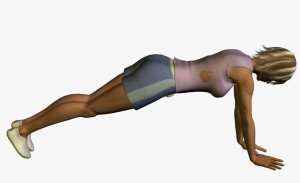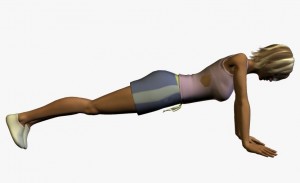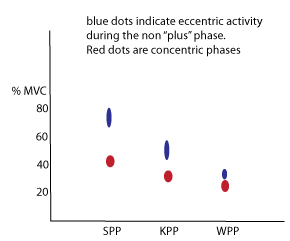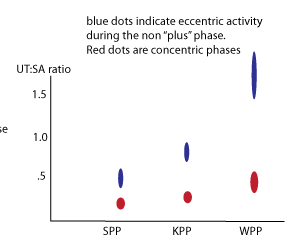Audience: Therapists
Purpose: I like the idea of quantifying the “dosage” of an exercise. We can do this with EMG and this post will be part of a larger theme that catalogues the EMG amplitude of various shoulder rehabilitation exercises. Further, it will also try to justify a number of exercises for their ability to avoid negative loading on the shoulder and promote a possibly optimal way of working the shoulder.
Caveat: This review only looks at a few papers addressing the Upper Traps (UT) to Serratus Anterior (SA) ratio. Other exercises must obviously be incorporated into a rehab program.
Exercises to maximize the Serratus Anterior (SA) to Upper Trapezius (UT) Ratio
To simplify: SA = good, UT = bad. Basically, activation of the SA moves the scapula out of the way of the humerus while too much or too early activation of the UT tends to
anteriorly tilt the scapula and decrease the space for humeral movement. Ann Cools has done extensive work in this area. Here is a taste of her findings and recommendations. You may want to consider using the exercises when you have a little scapular dyskinesis on your hands - you may see some medial border prominence of the scap, some winging during arm elevation and the scap can get a little jiggy with arm raising and lowering.
Three exercises were selected as exercises with a low UT/LT ratio:
- side-lying external rotation,
- side-lying forward flexion, and
- prone horizontal abduction with external rotation.
Three exercises were selected for minimizing the UT/LT ratio:
- side-lying forward flexion
- side-lying external rotation and
- horizontal abduction with external rotation
The authors conclude that no exercise satisfied their criteria for optimally minimizing the UT:SA Ratio. But honourable mention was given to forward flexion and scaption with External Rotation. We therefore have to look to other research to find the best exercise for this ratio - that exercise would be the Push Up Plus which demonstrates a ratio less than 20% for the “plus” portion of the push up and less than 50% for the push up portion of the push up. Serratus Anterior activity waltzes in at more than 120% for the plus portion and greater than 80% for the push up portion. Upper trap activity is between 20% for the push up portion and around 9% for the plus phase. See Ludewig (2004) for the full paper
Some Raw Data
I have bastardized a table from the Supplementary Data of the Ann Cools article. The following table shows the EMG activity (expressed as a percent of maximum for the Lower Traps, Middle Traps, Upper Traps and Serratus Anterior). For simplicity I have only included the isometric portion of the exercise. The original article also looked at the concentric and eccentric phases. Also in the chart is the Ratio of the above musculature to the Upper Trapezius. Remember, the ideal is be lower. Suggesting less Upper Trap activity and more of something else.
Table 1: EMG and Ratio Activity during various Rehab exercises (modified from Cools et al 2007)
| EMG - % of MVC* | Ratios | ||||||
| Exercise | UT | MT | LT | SA | UT/LT | UT/MT | UT/SA |
| Prone shoulder abduction | 50 | 78.4 | 76.7 | 14 | 75 | 71 | 597 |
| Forward flexion | 38 | 26.5 | 29.5 | 95.2 | 250 | 236 | 53 |
| Forward flexion in side-lying position | 8.6 | 35.5 | 63.7 | 34 | 16 | 27 | 50 |
| High row | 7.3 | 17.3 | 17.5 | 28.6 | 62 | 51 | 50 |
| Horizontal abduction | 33.7 | 63.8 | 50.3 | 17.3 | 77 | 60 | 339 |
| Horizontal abduction with external rotation | 43.7 | 78.2 | 79.2 | 15.5 | 65 | 65 | 467 |
| Low row (1) | 19.5 | 30.4 | 26.2 | 35.1 | 120 | 76 | 108 |
| Low row (2) | 21.6 | 31.9 | 20.3 | 19.9 | 162 | 77 | 206 |
| Prone extension | 15.9 | 30.1 | 30.9 | 34.7 | 82 | 62 | 84 |
| Rowing in sitting | 31.4 | 41.6 | 29.8 | 12.1 | 122 | 105 | 458 |
| Scaption with external rotation | 44.9 | 31.7 | 32.3 | 101.7 | 273 | 246 | 51 |
| Side-lying external rotation | 5.54 | 18.2 | 51.1 | 9.8 | 14 | 39 | 92 |
The next table describes all of the exercises.
Table 2: Exercise Description
| Exercise | Description |
| Prone shoulder abduction | Subject prone with the shoulder in neutral position; subject performs shoulder abduction abduction to 90° with external rotation in a horizontal plane |
| Forward flexion | Subject standing with shoulder in neutral position; subject performs maximal forward flexion in a sagittal plane |
| Forward flexion in side-lying position | Subject in side-lying position, shoulder in neutral position; subject performs forward side-lying position flexion in a horizontal plane to 135° |
| High row | Subject standing in front of vertical pulley apparatus with the shoulders in135° forward flexion; subject performs an extension with the shoulders until neutral |
| Horizontal abduction | Subject prone with the shoulders resting in 90° forward flexion; subject performs horizontal abduction to horizontal position |
| Horizontal abduction with external rotation | Subject prone with the shoulders resting in 90° forward flexion; subject performs horizontal abduction to horizontal position, with an additional external rotation of the shoulder |
| Low row (1) | Subject standing in front of pulley apparatus, shoulders in 45° forward flexion an |
| Low row (2) | Subject standing in front of pulley apparatus, shoulders in 45° forward flexion and neutral rotation; subject performs extension with the elbows flexed |
| Prone extension | Subject prone with the shoulders resting in 90° forward flexion; subject performs extension to neutral position with the shoulder in neutral rotational |
| Rowing in sitting | Subject sitting in front of pulley apparatus with the shoulders in 90° forward flexion;position with 2 handles subject performs an extension movement with the elbows flexed and in the horizontal |
| Scaption with external rotation | Subject sitting with the arms at the side; subject performs maximal elevation of the arms rotation in the plane of the scapula (30° anterior of the frontal plane) |
| Side-lying external rotation | Subject side-lying with the shoulder in neutral position and the elbow flexed 90°; subject rotation performs external rotation of the shoulder (with towel between trunk and elbow to avoid compensatory movements) |
WHY IS THIS RELEVANT?
I think this paper tells us that these are not the exercises that we should be doing if we think that the ratio between UT and the SA is the biggest problem. When we look at the EMG values and not just the ratios we can see that few of the exercises investigated appropriately challenge the SA with the exception of Forward Flexion and Scaption. Fortunately, they also have relatively good UT:SA ratios (please note, when performed dynamically the ratio is higher, in other words worse for the shoulder). If we look at previous research by Paula Ludewig who investigated Push Up Plus variations we learn that sticking with the Push Up Plus is still the ideal exercise to train the SA while minimizing Upper Traps.
Do Push Up Plus Exercises for the best UT:SA Ratio
As for the push up plus and its varations (Standard Push Up Plus (SPP), Knee Pushup Plus (KPP) and Wall Pushup Plus) look at the Serratus EMG activity and the associated ratios in the following modified charts.
The chart to the left shows eccentric (blue) and concentric (red) EMG activity during the non “plus” portion of the push up plus. The “plus” portion is 20-40% MVC higher. This graph shows that the Push Up Plus activates the Serratus between 40-80% of its maximum (depending on type of movement). The Plus portion achieves values close to 120% of maximum. Kneeling push up plus (KPP) and Wall Pushup Plus (WPP) tend to have less activity.
When we look at the Upper Trapezius to Serratus Anterior ratio we find the lowest ratios occur with the Standard Push Up Plus. Showing less than 50% for both concentric and eccentric portions of the push up activity (non plus phase) and less than 20% ratio during the “plus” phases of the activity (not in the chart) as I wanted to show the worst case scenario. Note how the wall push up starts to have a lot more Trap activity and therefore it throws the UT:SA ratio way to high for it to be ideal. Upper trap activity typically reaches between 15 and 25% during the eccentric portion of the pushup and between 6-12% during the eccentric portion of the “plus” phase of the push up plus.
Bottom Line: The standard push up and standard push up plus demonstrate the highest levels of Serratus Anterior EMG activation as well as the lowest ratio the UT:SA activity. The wall push up plus should be avoided and it may even lead to impingement.
Further References
Reinold MM, Escamilla RF, Wilk KE. Current concepts in the scientific and clinical rationale behind exercises for glenohumeral and scapulothoracic musculature. J Orthop Sports Phys Ther. 2009 Feb;39(2):105-17. Review.
Kibler WB, Ludewig PM, McClure P, Uhl TL, Sciascia A.Scapular Summit 2009: introduction. July 16, 2009, Lexington, Kentucky. J Orthop Sports Phys Ther. 2009 Nov;39(11):A1-A13. Review.
Escamilla RF, Yamashiro K, Paulos L, Andrews JR.Shoulder muscle activity and function in common shoulder rehabilitation exercises. Sports Med. 2009;39(8):663-85. Review.
Ludewig PM, Hoff MS, Osowski EE, Meschke SA, Rundquist PJ Relative balance of serratus anterior and upper trapezius muscle activity during push-up exercises. Am J Sports Med. 2004 Mar;32(2):484-93
Cools AM, Dewitte V, Lanszweert F, Notebaert D, Roets A, Soetens B, Cagnie B, Witvrouw EE.Rehabilitation of scapular muscle balance: which exercises to prescribe? Am J Sports Med. 2007 Oct;35(10):1744-51. Epub 2007 Jul 2.
Raw Data








Good stuff. To my knowledge, however, it is yet to be determined what the optimal ratio/range of UT:SA should be, given that there is a force couple relationship which must be considered. Lower may be better in some cases but middle of the road ratios may be fine for others. Certainly if you are looking to retrain/strengthen SA then the SPP looks to be your winner, but there are other situations (varying functional requirements) that could require a different ratio altogether. Thanks for the work.
Thanks Bob,
That is a good point and I agree that middle of the road may be OK. We certainly have not done the research to correlate different UT:SA ratios and activation levels with the degree of impingement that someone experiences.
[...] push up plus exercise - a greater exercise for the Serratus Anterior (see blog here on the Serratus Anterior ). You can obviously add weight to the hand as is NOT seen in the picture below… always [...]